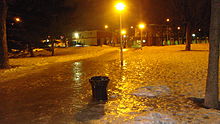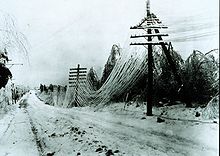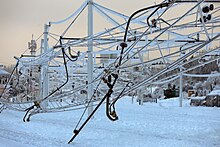ice rain
| 56 | Light freezing drizzle | |
| 57 | Moderate or heavy freezing drizzle | |
| 66 | Light freezing rain | |
| 67 | Moderate or heavy freezing rain | |
| 24 | Freezing rain or drizzle stopped in the last hour | |
|
Forest and power lines damaged by freezing rain (USA, undated) |
||
Under freezing rain (in the synoptic meteorology freezing rain , in common usage and black ice , accompanied by a strong wind event and ice storm ) is defined as a weather event , in which rain within a very short time on the ground freezes . This can lead to severe winter slippery conditions, in extreme cases all surfaces are covered with thick ice, which leads to ice breakage of trees, buildings or plants.
causes


In terms of atmospheric physics, three cases can be distinguished:
- When normal raindrops freeze instantly on the frozen ground, this is known as freezing rain (in the narrower sense) or rough ice .
- If thermodynamically supercooled raindrops suddenly freeze upon impact with the ground, it is called supercooled rain or clear ice , respectively, ice (in the narrow sense). The drops have below zero degrees water temperature, but have not yet found a trigger to crystallize. This happens suddenly due to the mechanical impulse.
- The third case, that the drops freeze and crystallize in the air. Of "freezing rain" this is referred to in the transition area between rain and snowfall (about sleet ) or rain and hail (and especially freezing rain for Eiskorn precipitate ). Some varieties can also freeze together on the ground.
Freezing rain belongs to the group of hydrometeors , and to weather-related ice deposits. The terms clear ice / black ice ( English glaze ) and rough ice describe that the former forms compact, translucent ice, the latter one with air inclusions or multiple crystal boundaries.
In synoptic meteorology ( weather forecast ), on the other hand, a distinction is primarily made between freezing rain from drizzle and normal rain, the former is typically that which leads to icing on the ground at low temperatures because the very small droplets freeze much faster.
Freezing rain typically occurs when a low pressure area hits a cold air mass with its cold or warm front . By sliding up , precipitation occurs , which turns into ice. Depending on the heights at which the different warm and cold layers are, the different forms of freezing rain arise. The supercooled rain is characteristic of warm fronts.
The difference between the physical case distinctions is that the undercooling effect can also occur at temperatures above zero degrees, while freezing rain has already been preceded by a more massive cold phase: At shorter temperatures just below freezing point, the cold stored in the ground is insufficient, the rain to freeze. Therefore, events of supercooled rain are much more difficult to predict than those of freezing rain, because the cause is sub-zero temperatures in higher air layers, where the air movements are faster and more difficult to understand. On the other hand, if a rain front is expected to arrive after a phase of −10 ° C, for example, black ice can be predicted with a high degree of probability.
The events often set in very suddenly and lead to black ice within a few minutes and sometimes to thick layers of ice within a few hours. Both types of events often only take place in small areas or in stroke zones, and can also last for a very short time. In principle - like all events at the zero degree limit - they are often difficult to predict precisely and very difficult to model .
A neologism for this phenomenon has been the term lightning ice since the beginning of the 1990s (presumably due to the surprise effect of the ice layer, which is often invisible at the beginning), which has since been used across the board for every form of freezing moisture, also for some forms of freezing humidity or freezing fog , which also lead to slippery ice (precisely: slippery frost ) and ice breakage. In contrast to freezing rain, these occur primarily in windless conditions, such as dew , and form comparatively slowly. It is characteristic that freezing rain either envelops objects all around or icicles-like grows downwards, but frost, if it is not completely calm, forms horizontal flags on the leeward side.
In the event of individual weather events, the various forms of deposits may well overlap and overlap. The exact delimitation of the terms is also different depending on the author or usage.
Occurrence
Freezing rain events, for example, are very characteristic of the east coast of North America and occur regularly in eastern Canada and New England . Here around Newfoundland, humid air masses and arctic-continental cold air masses regularly meet. In Europe, however, such events are an exception.
Freezing rain events are also a major problem in air traffic. Here, too, the two cases of freezing and supercooled rain are a problem: On the one hand, aircraft are already very cold due to the high altitude themselves, so they are at risk of icing. In the case of supercooled rain, the aircraft can act as the same mechanical freeze trigger as the impact of raindrops on the ground, so that lightning-like icing is possible even on the approach, which seriously disrupts flight behavior. Therefore, in air traffic, one usually speaks of clear ice as a problem.
In the high mountains, freezing rain is extremely feared by mountaineers because it makes even the simplest paths completely impassable.
List of freezing rain events
- February 1994: Ice storm in Mississippi, Tennessee and Alabama with damage of over $ 1 billion
- American Eagle Flight 4184, October 1994: crash in freezing rain with 68 victims.
- January 1998: Great Ice Storm in Eastern Canada and New England, around $ 6 billion in damage
- February 2014: Mediterranean low "Mayla" , severe damage to infrastructure in Slovenia
- December 2014: Mediterranean low "Medea" , from Bohemia to Hungary
See also
- Snow load (structural engineering, also applies to ice)
literature
- Gustav Hellmann: About the formation of freezing rain. Edition 46 of the meeting reports of the Prussian Academy of Sciences, 1912.
Web links
Individual evidence
- ↑ a b c Eisregen, ( Memento of the original from December 8, 2014 in the Internet Archive ) Info: The archive link was automatically inserted and not yet checked. Please check the original and archive link according to the instructions and then remove this notice. DWD Weather Lexicon (accessed December 3, 2014).
- ↑ a b c d Freezing Rain - supercooled droplets freezing on impact and Cyclones and Fronts - the development of freezing rain. University of Illinois entries: WW2010 .
- ↑ a b c d e Joachim Blüthgen, Wolfgang Weischet: General climate geography. Volume 2 by Wolfgang Weischet (Ed.): Textbook of general geography . Walter de Gruyter, 1980, ISBN 3-11-006561-4 , section deposits, p. 281 ff. ( Limited preview in the Google book search).
- ↑ This statement is physically imprecise: It is not "cold stored", but a deficit of thermal energy compared to the environment.
- ↑ Frankfurter Allgemeine Zeitung, 1993: “In Berlin, the […] announced lightning ice cream initially did not take place.” Quoted in New Vocabulary. Neologisms of the 90s in German. Gruyter Verlag, 2004, p. 33 ( limited preview in Google book search).
- ↑ cf. for example the sample photos in Blüthgen, Weischet: Allgemeine Klimageographie, p. 282 f.
-
^ Susan Munroe: The Canadian ice storm of 1998. In: canadaonline.about.com ;
→ en: American Eagle Flight 4184 - ^ → en: North American Ice Storm of 1998








